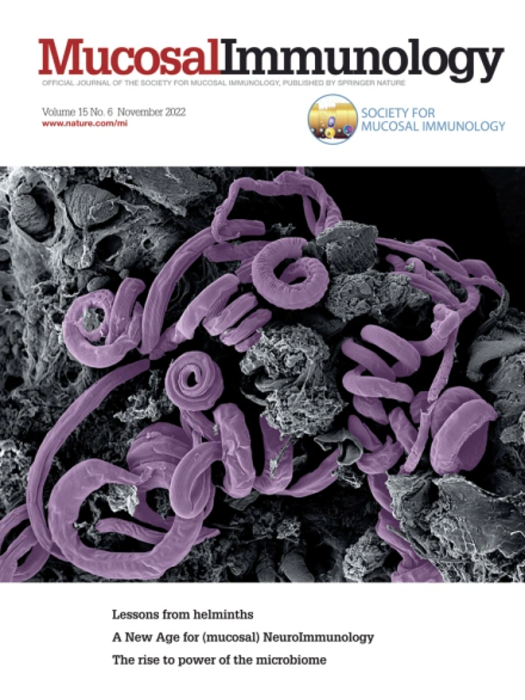Tear duct M cells exacerbate allergic conjunctivitis by facilitating germinal-center reactions
IF 7.6
2区 医学
Q1 IMMUNOLOGY
引用次数: 0
Abstract
The ocular mucosal surface regularly encounters external materials in the air and tear fluids. Microfold (M) cells, specialized epithelial cells for antigen uptake, are present in tear duct-associated lymphoid tissue (TALT) within the nasolacrimal sac; however, their immunological significance is unclear. We generated Krt5-Cre Tnfrsf11aflox/flox mice, which lack functional M cells in the TALT, as evidenced by the absence of M-cell markers and reduced nanoparticle uptake. M cell deficiency resulted in fewer T follicular helper (Tfh) and germinal center (GC) B cells in the TALT under steady-state conditions. Upon induction of allergic conjunctivitis, control mice exhibited itching and increased Tfh and immunoglobulin E (IgE+) GC B cells in the TALT. However, M cell-deficient mice showed ameliorated allergic symptoms with fewer Tfh and IgE+ GC B cells. These findings suggest that M cells in TALT contribute to ocular surface immunosurveillance, whereas, upon allergen exposure, they play a critical role in the development of allergic conjunctivitis.

泪管M细胞通过促进生发中心反应而加剧过敏性结膜炎。
眼粘膜表面经常遇到空气和泪液中的外部物质。微褶细胞(M)是用于抗原摄取的特化上皮细胞,存在于鼻泪囊内的泪管相关淋巴组织(TALT)中;然而,它们的免疫学意义尚不清楚。我们培育了Krt5-Cre Tnfrsf11aflox/flox小鼠,这些小鼠在TALT中缺乏功能性M细胞,这可以通过缺乏M细胞标记物和减少纳米颗粒摄取来证明。在稳态条件下,M细胞缺乏导致TALT中T滤泡辅助细胞(Tfh)和生发中心(GC) B细胞减少。在过敏性结膜炎诱导下,对照组小鼠出现瘙痒,TALT中Tfh和免疫球蛋白E (IgE+) GC B细胞增加。然而,M细胞缺陷小鼠的过敏症状得到改善,Tfh和IgE+ GC B细胞减少。这些发现表明,TALT中的M细胞有助于眼表免疫监测,然而,在过敏原暴露时,它们在过敏性结膜炎的发展中起关键作用。
本文章由计算机程序翻译,如有差异,请以英文原文为准。
求助全文
约1分钟内获得全文
求助全文
来源期刊

Mucosal Immunology
医学-免疫学
CiteScore
16.60
自引率
3.80%
发文量
100
审稿时长
12 days
期刊介绍:
Mucosal Immunology, the official publication of the Society of Mucosal Immunology (SMI), serves as a forum for both basic and clinical scientists to discuss immunity and inflammation involving mucosal tissues. It covers gastrointestinal, pulmonary, nasopharyngeal, oral, ocular, and genitourinary immunology through original research articles, scholarly reviews, commentaries, editorials, and letters. The journal gives equal consideration to basic, translational, and clinical studies and also serves as a primary communication channel for the SMI governing board and its members, featuring society news, meeting announcements, policy discussions, and job/training opportunities advertisements.
 求助内容:
求助内容: 应助结果提醒方式:
应助结果提醒方式:


